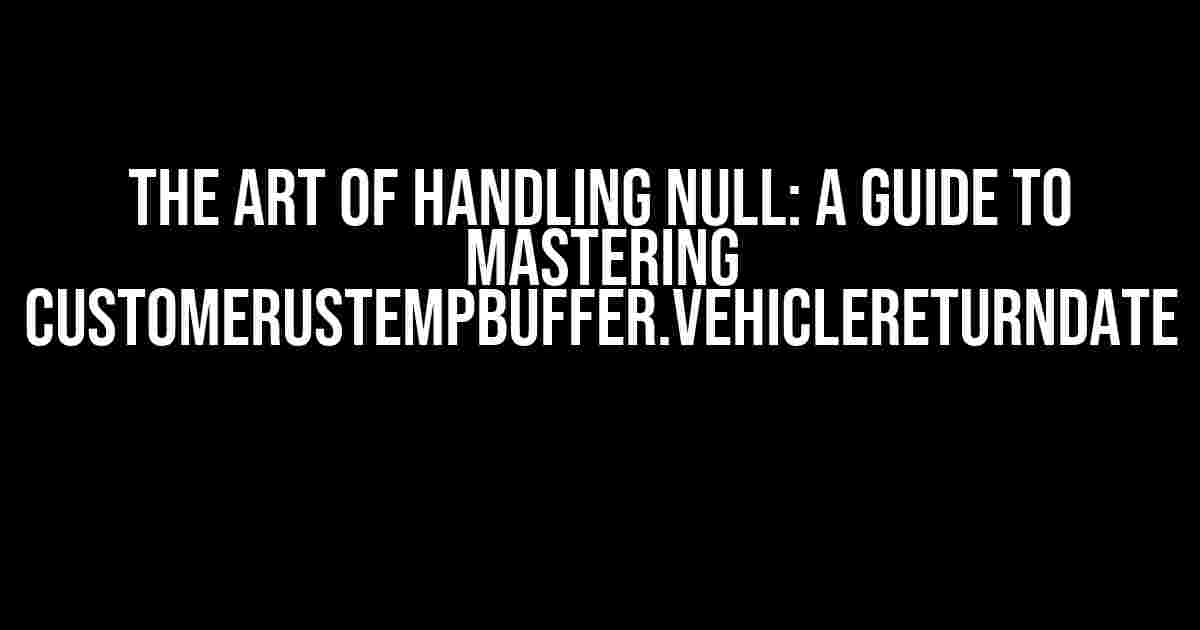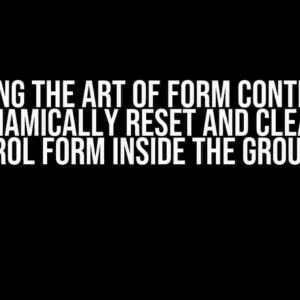As a developer, you’ve probably encountered the infamous “NullReferenceException” more times than you can count. It’s like that one pesky colleague who always seems to find a way to crash your party. But fear not, dear reader, for today we’re going to tackle one of the most common null-related conundrums: how to handle null in the context of CustomerUSTempBuffer.vehiclereturndate.
Understanding the Problem
The issue at hand is this: you’re trying to parse a date from a string using the DateTime.Parse() method, but the value returned by line.Substring(973, 8).Trim() might be null. This can happen for various reasons, such as:
- The input string is malformed or incomplete.
- The Substring operation returns an empty string.
- The Trim() method removes all characters, resulting in an empty string.
If you attempt to parse a null value, you’ll get a NullReferenceException, which will bring your program to a screeching halt.
The Consequences of Ignoring Null
So, what happens if you ignore the possibility of null and proceed with the parsing operation anyway? Well, let’s just say it’s not a pretty sight:
try {
CustomerUSTempBuffer.vehiclereturndate = DateTime.Parse(line.Substring(973, 8).Trim());
} catch (NullReferenceException ex) {
Console.WriteLine("Oh no! NullReferenceException caught!");
}
In this example, the program will throw a NullReferenceException when trying to access the Trim() method on a null value. This will not only crash your program but also make it difficult to debug, as the error message won’t provide much context.
The Art of Null Handling
Now that we’ve established the importance of handling null, let’s dive into the verschiedenen approaches to tackle this issue.
Method 1: The Null Check
The most straightforward way to handle null is to perform a simple null check before attempting to parse the date:
string dateString = line.Substring(973, 8).Trim();
if (dateString != null) {
CustomerUSTempBuffer.vehiclereturndate = DateTime.Parse(dateString);
} else {
// Handle the null case (e.g., log an error or set a default value)
}
This approach is simple and effective, but it can become cumbersome if you need to perform multiple null checks throughout your code.
Method 2: The Null-Coalescing Operator
A more elegant solution is to use the null-coalescing operator (??) to provide a default value in case the parsed date is null:
CustomerUSTempBuffer.vehiclereturndate = DateTime.Parse(line.Substring(973, 8).Trim() ?? "1900-01-01");
In this example, if the parsed date is null, the default value “1900-01-01” will be assigned to CustomerUSTempBuffer.vehiclereturndate.
Method 3: The TryParse Method
The DateTime.TryParse() method is specifically designed to handle null or invalid date strings. It returns a boolean indicating whether the parsing operation was successful:
string dateString = line.Substring(973, 8).Trim();
DateTime parsedDate;
if (DateTime.TryParse(dateString, out parsedDate)) {
CustomerUSTempBuffer.vehiclereturndate = parsedDate;
} else {
// Handle the invalid date string case
}
This approach is more robust than the previous two, as it allows you to handle both null and invalid date strings in a single operation.
Best Practices for Handling Null
When it comes to handling null, it’s essential to follow best practices to ensure your code is robust and maintainable:
- Always validate user input: Before attempting to parse a date or perform any operation, make sure the input data is valid and not null.
- Use null-checks or null-coalescing operators: Perform explicit null checks or use the null-coalescing operator to provide default values in case of null.
- Avoid throwing exceptions: Instead of letting exceptions propagate, handle null-related issues locally to maintain program stability.
- Document null cases: Clearly document the null cases in your code to ensure other developers understand the handling mechanism.
Conclusion
In conclusion, handling null in the context of CustomerUSTempBuffer.vehiclereturndate requires attention to detail and a solid understanding of the null-related pitfalls. By following the best practices outlined in this article, you’ll be well-equipped to tackle even the most complex null-related issues.
| Method | Description | Pros | Cons |
|---|---|---|---|
| Explicitly check for null before parsing | Simple and effective | Cumbersome for multiple null checks | |
| Provide a default value in case of null | Elegant and concise | Limited flexibility | |
| Robustly handle null or invalid date strings | Robust and flexible | More complex syntax |
Remember, handling null is not just about avoiding exceptions; it’s about writing robust, maintainable, and scalable code that can handle the unexpected.
Frequently Asked Question
Handling null values in code can be a real challenge, especially when working with dates. Let’s dive into some frequently asked questions about handling null in this situation: CustomerUSTempBuffer.vehiclereturndate = DateTime.Parse(line.Substring(973, 8).Trim());
What happens if the Substring returns null?
If the Substring returns null, the DateTime.Parse method will throw a ArgumentNullException. To avoid this, you can check if the Substring is null before trying to parse it.
How can I check for null before parsing the date?
You can use a simple if statement to check if the Substring is null before trying to parse it. For example: if (line.Substring(973, 8).Trim() != null) { CustomerUSTempBuffer.vehiclereturndate = DateTime.Parse(line.Substring(973, 8).Trim()); }
What if I want to set a default date if the Substring is null?
You can use the null-coalescing operator (??) to set a default date if the Substring is null. For example: CustomerUSTempBuffer.vehiclereturndate = DateTime.Parse(line.Substring(973, 8).Trim()) ?? DateTime.MinValue;
Can I use TryParse instead of Parse?
Yes, you can use TryParse instead of Parse. TryParse will return false if the parsing fails, instead of throwing an exception. For example: DateTime returndate; if (DateTime.TryParse(line.Substring(973, 8).Trim(), out returndate)) { CustomerUSTempBuffer.vehiclereturndate = returndate; }
How can I handle empty strings or whitespace?
You can use the String.IsNullOrEmpty or String.IsNullOrWhiteSpace methods to check if the Substring is empty or contains only whitespace. For example: if (!String.IsNullOrWhiteSpace(line.Substring(973, 8).Trim())) { CustomerUSTempBuffer.vehiclereturndate = DateTime.Parse(line.Substring(973, 8).Trim()); }


